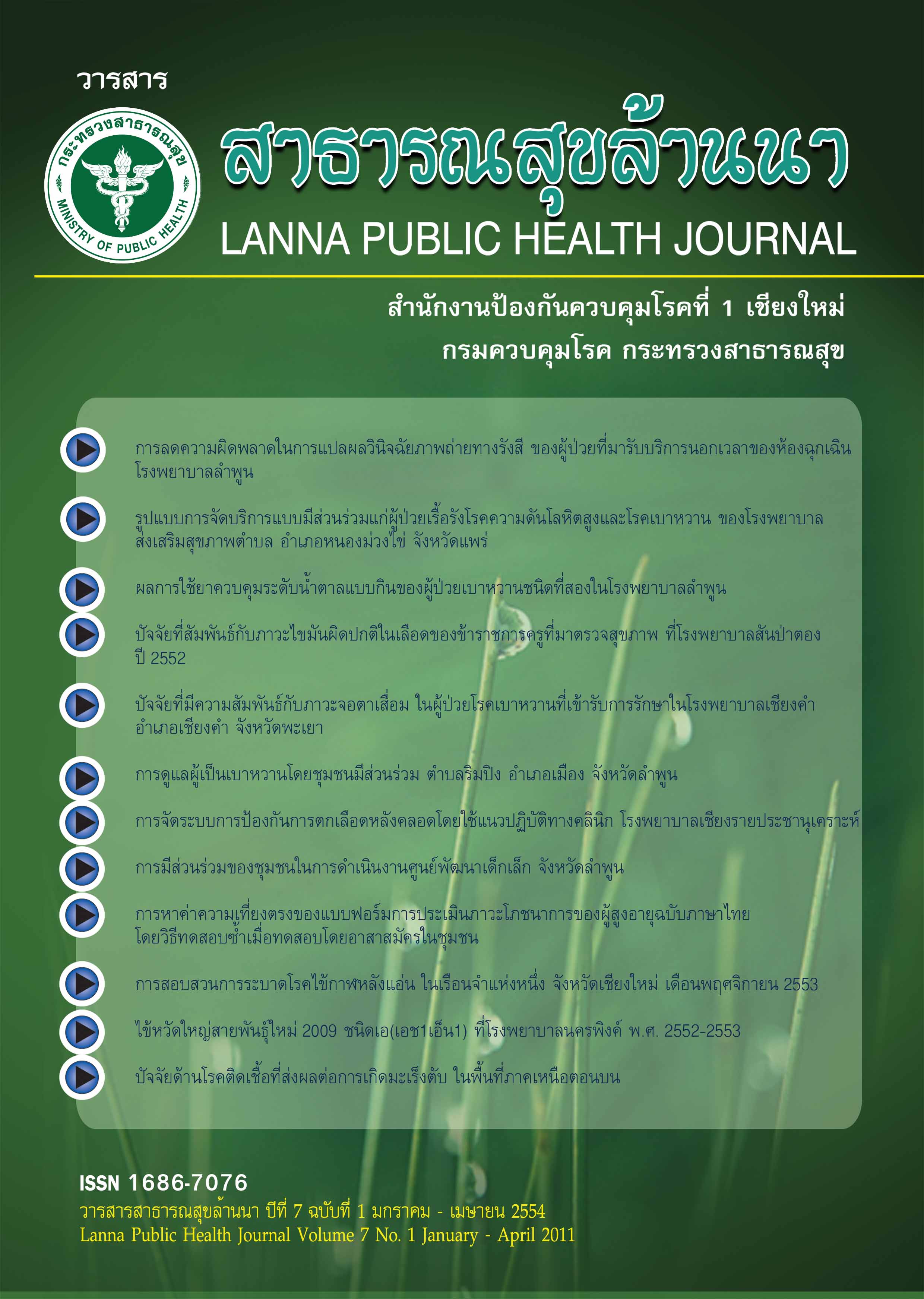ไข้หวัดใหญ่สายพันธุ์ใหม่ 2009 ชนิดเอ(เอช1เอ็น1) ที่โรงพยาบาลนครพิงค์ พ.ศ. 2552-2553
คำสำคัญ:
ไข้หวัดใหญ่สายพันธุ์ใหม่ 2009 ชนิดเอ(เอช1เอ็น1), โรงพยาบาลนครพิงค์บทคัดย่อ
ไข้หวัดใหญ่สายพันธุ์ใหม่ 2009 ชนิดเอ(เอช1เอ็น1) ได้มีการแพร่ระบาดในประเทศไทยตั้งแต่ช่วงกลางปี พ.ศ.2552 เป็นต้นมา และโรงพยาบาลนครพิงค์ซึ่งเป็นโรงพยาบาลประจำจังหวัดเชียงใหม่ได้ทำการตรวจรักษาผู้ป่วยไข้หวัดใหญ่และผู้ป่วยโรคระบบทางเดินหายใจอื่นเพิ่มขึ้นเป็นจำนวนมาก การศึกษาครั้งนี้มีวัตถุประสงค์เพื่ออธิบายสถานการณ์ของโรคไข้หวัดใหญ่สายพันธุ์ใหม่ 2009 ชนิดเอ(เอช1เอ็น1) ที่โรงพยาบาลนครพิงค์ในช่วงปีพ.ศ.2552-2553 การศึกษานี้เป็นการศึกษาเชิงพรรณนาย้อนหลังโดยการวิเคราะห์ข้อมูลทุติยภูมิจากระบบฐานข้อมูลของโรงพยาบาลและข้อมูลการเฝ้าระวังและสอบสวนโรคไข้หวัดใหญ่ โดยการแจกแจงเป็นความถี่และร้อยละ แล้วนำเสนอในรูปแผนภูมิและตาราง ผลการศึกษาพบว่ามีการเพิ่มขึ้นของผู้ป่วยโรคระบบทางเดินหายใจ ผู้ป่วยอาการคล้ายไข้หวัดใหญ่ ผู้ป่วยโรคไข้หวัดใหญ่และผู้ป่วยไข้หวัดใหญ่สายพันธุ์ใหม่ 2009 ชนิดเอ(เอช1เอ็น1) รวมถึงการส่งสิ่งส่งตรวจจากลำคอเพื่อตรวจยืนยันเชื้อและการให้ยาต้านไวรัส Oseltamivir ก็มีจำนวนเพิ่มมากขึ้นด้วย โดยเฉพาะในช่วงที่มีการระบาดทั้งสามระลอกคือช่วงเดือนมิถุนายนถึงกันยายน พ.ศ. 2552 เดือนมกราคมถึงกุมภาพันธ์ และเดือนกันยายนถึงตุลาคม พ.ศ. 2553 อาการที่พบมากในผู้ป่วยที่ติดเชื้อไข้หวัดใหญ่สายพันธุ์ใหม่ 2009 ชนิดเอ(เอช1เอ็น1) คืออาการไข้ พบร้อยละ 95.4 รองลงไปคืออาการไอและอาการเจ็บคอ พบร้อยละ 88.8 และ 54.6 ตามลำดับ ผู้ป่วยประมาณสามในสี่มีอายุต่ำกว่า 25 ปี โดยพบมากที่สุดในช่วงอายุ 10 – 14 ปี รองลงไปคือ 15 – 19 ปี, 5 – 9 ปี, 20 – 24 ปี และ 0 – 4 ปี ตามลำดับ ดังนั้นจึงควรมีการเฝ้าระวังการระบาดเป็นกลุ่มก้อนในประชากรกลุ่มที่มีอายุน้อยกว่า 25 ปีและควบคุมการแพร่ระบาดให้ทันท่วงที เพื่อป้องกันการแพร่กระจายสู่ชุมชนส่วนการให้ให้ยาต้านไวรัสควรเน้นให้ในเฉพาะกลุ่มเสี่ยงหรือผู้ป่วยที่มีอาการรุนแรงเป็นหลัก เพื่อหลีกเลี่ยงการใช้ยาต้านไวรัสเกินความจำเป็น
เอกสารอ้างอิง
Kilbourne ED. Influenza pandemics of the 20th century. Emerg Infect Dis [serial on the internet].2006 Jan; 12(1): [11 screens]. Available from: http://www.cdc.gov/ncidod/EID/vol12no01/05-1254.htm. Accessed September 2, 2009.
Taubenberger JK, Morens DM. 1918 influenza: the mother of all pandemics. Emerg Infect Dis [serial on the internet]. 2006 Jan; 12(1): [14 screens]. Available from: http://www.cdc.gov/ncidod/EID/vol12no01/05-0979.htm. Accessed September 2,2009.
Padilla RP, Zamboni DR, Leon SP, et al. Pneumonia and respiratory failure from swine-origin influenza A(H1N1) in Mexico. N Engl J Med 2009; 361: 680-689.
Zhang H, Chen L. Possible origin of current influenza A H1N1 viruses. Lancet 2009; 9: 456-457.
Novel swine-origin influenza A(H1N1) virus investigation team. Emergence of a novel swineorigin influenza A(H1N1) virus in humans. N Engl J Med 2009; 360: 2605-2615.
Trifonov V, Khiabanian H, Rabadan R. Geographic dependence, surveillance, and origins of the 2009 influenza A(H1N1) virus. N Engl J Med 2009; 361: 115-119.
Chan M. Influenza A(H1N1). Statement by WHO Director-General [serial online]. 2009 Apr: [2 screens].
Available from: http://www.who.int/mediacentre/news/statements/2009/h1n1_20090429/en/index.html. Accessed September 7, 2009.
Chan M. World now at the start of 2009 influenza pandemic. Statement by WHO Director-General [serial
online]. 2009 Jun: [3 screens]. Available from: http://www.who.int/mediacentre/news/statements/2009/h1n1_pandemic_ phase6_20090611 /en/index.html. Accessed September 7, 2009.
สำนักโรคติดต่ออุบัติใหม่ กรมควบคุมโรค กระทรวงสาธารณสุข. การเฝ้าระวังโรคไข้หวัดใหญ่สายพันธุ์ใหม่ ชนิด A(H1N1).(ระบบออนไลน์). แหล่งที่มา:http://beid.ddc.moph.go.th/th/images/news/situationh1n1/thai/flu130552.pdf.
สำนักโรคติดต่ออุบัติใหม่ กรมควบคุมโรค กระทรวงสาธารณสุข. การเฝ้าระวังโรคไข้หวัดใหญ่สายพันธุ์ใหม่ ชนิด A(H1N1).(ระบบออนไลน์). แหล่งที่มา:http://203.157.15.4/Flu/situation/y52/flu_200907221608.pdf.
ศูนย์ข่าวเชียงใหม่. เชียงใหม่พบผู้ป่วยไข้หวัดใหญ่สายพันธุ์ใหม่รายแรก. ASTVผู้จัดการออนไลน์ 14 มิถุนายน 2552. (ระบบออนไลน์). แหล่งที่มา: http://www.manager.co.th/Local/ViewNews.aspx?NewsID=9520000067084.
Chan M. H1N1 in post-pandemic period. Statement by WHO Director-General [serial online]. 2010 Aug: [3 screens]. Available from: http://www.who.int/mediacentre/news/statements/2010/h1n1_vpc_20100810/en/ index.html. Accessed January 21, 2011.
Hancock K, Veguilla V, Lu X, et al. Cross-reactive antibody responses to the 2009 pandemic H1N1 influenza virus. N Engl J Med 2009; 361: 1945-52.
Ison MG, Lee N. Influenza 2010-2011: Lessons from the 2009 pandemic. Cleve Clin J Med 2010; 77(11): 812-820.
Tang JW, Tambya PA, Lai FY, et al. Differing symptom patterns in early pandemic vs seasonal influenza infections. Arch Intern Med 2010; 170(10): 861-867.
Writing committee of the WHO consultation on clinical aspects of pandemic(H1N1) 2009 influenza. Clinical aspects of pandemic 2009 influenza A(H1N1) virus infection. N Engl J Med 2010; 362: 1708-19.
Centers for disease control and prevention(CDC). Oseltamivir-resistant novel influenza A(H1N1) virus infection in two immunosuppressive patients--- Seattle, Washington, 2009. MMWR Morb Mortal Wkly Rep 2009; 58(Dispatch): 1-4.








